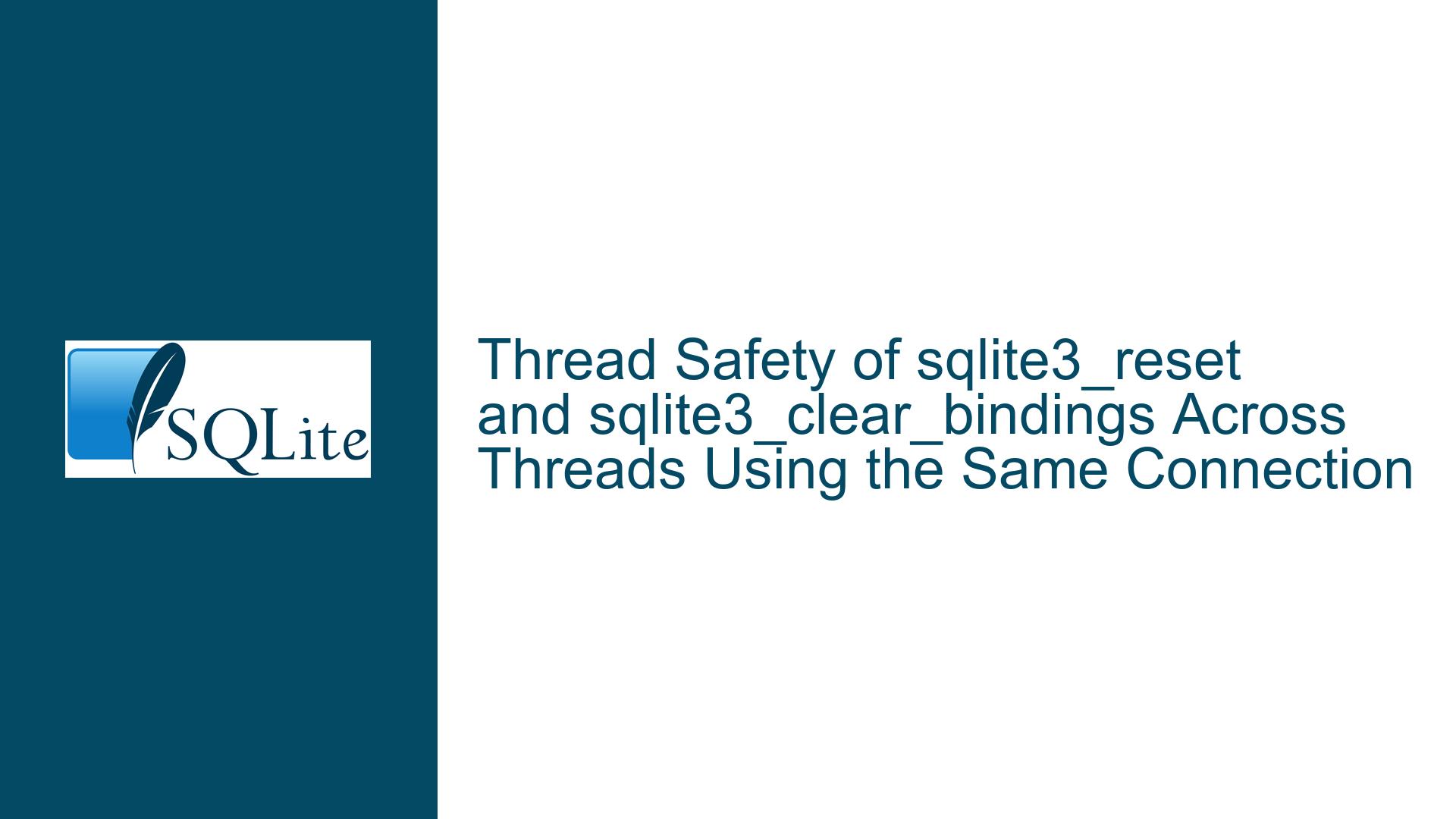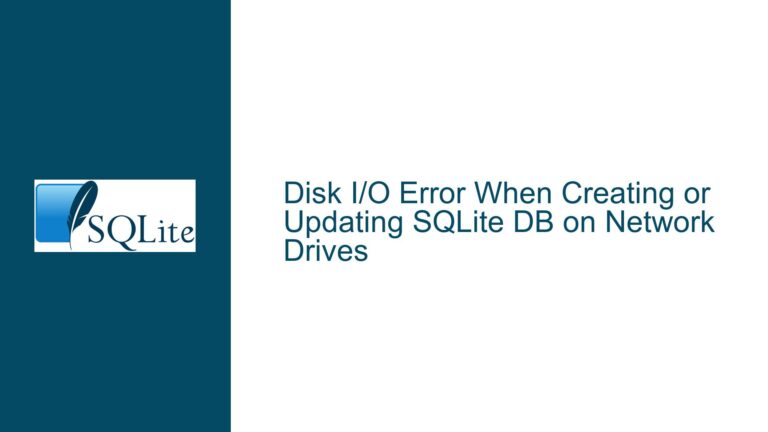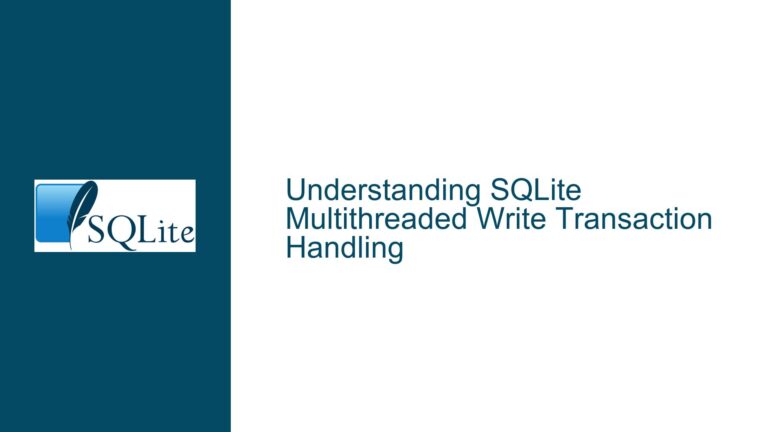Thread Safety of sqlite3_reset and sqlite3_clear_bindings Across Threads Using the Same Connection
Understanding SQLite Threading Models and Shared Connection Access
Issue Overview
The core challenge revolves around safely reusing a prepared statement across multiple threads with a single SQLite database connection. The goal is to offload sqlite3_reset and sqlite3_clear_bindings operations to a background thread while the main thread continues using the same connection for other tasks, such as executing queries (sqlite3_exec), preparing new statements (sqlite3_prepare_v2), or stepping through results (sqlite3_step). The critical question is whether these operations can proceed concurrently without causing data races, undefined behavior, or database corruption.
SQLite’s threading safety is governed by its threading mode, which determines how the library manages concurrent access to connections, prepared statements, and other resources. The safety of cross-thread operations depends on three factors:
- The threading mode configured during compilation or runtime (single-thread, multi-thread, or serialized).
- The use of mutexes to synchronize access to shared resources like database connections.
- The lifetime and ownership of prepared statements across threads.
A prepared statement is tied to the connection that created it. Resetting or clearing bindings alters the statement’s internal state, which may conflict with ongoing operations in another thread. For example, if the main thread is stepping through a query result while a background thread resets the same statement, the sequence of operations could violate SQLite’s API constraints, leading to crashes or incorrect results.
Key Constraints in Multi-Threaded SQLite Environments
Possible Causes
The risks associated with performing sqlite3_reset and sqlite3_clear_bindings in a separate thread stem from the following:
Incorrect Threading Mode Configuration:
SQLite supports three threading modes:- Single-thread: All API calls must originate from the main thread.
- Multi-thread: Connections can be used across threads, but each connection must be isolated to a single thread at any time.
- Serialized: Full thread safety; multiple threads can share connections and prepared statements, provided mutexes are used correctly.
If the library is compiled or initialized in a mode other than serialized, concurrent access to the same connection from multiple threads is unsafe. For example, in multi-thread mode, a connection may be moved between threads, but simultaneous API calls are prohibited.
Lack of Mutex Synchronization:
Even in serialized mode, SQLite does not automatically enforce thread safety for all operations. The application must explicitly use the connection-specific mutex (retrieved viasqlite3_db_mutex) to guard critical sections. Failing to lock this mutex before callingsqlite3_resetorsqlite3_clear_bindingsin a background thread—while the main thread performs other operations—creates race conditions.Unsafe Statement Reuse Patterns:
Prepared statements are not inherently thread-safe. If a statement is actively being used in one thread (e.g., mid-sqlite3_stepiteration), resetting it in another thread could invalidate pointers, corrupt internal state, or trigger assertion failures. This is especially true if the statement is associated with an open transaction or pending result set.Database Locking Conflicts:
SQLite employs file locks to manage write concurrency. If the main thread initiates a write operation (e.g.,INSERTviasqlite3_exec) while the background thread attempts to reset a statement tied to the same connection, the internal lock hierarchy may be violated, leading to deadlocks orSQLITE_BUSYerrors.
Mitigating Risks and Ensuring Safe Concurrent Access
Troubleshooting Steps, Solutions & Fixes
Step 1: Verify and Configure Threading Mode
Confirm that SQLite is operating in serialized mode. This is the only mode where sharing connections across threads is permitted.
Check Compilation Flags:
Ensure the library was compiled with-DSQLITE_THREADSAFE=1(default on most platforms). If unsure, callsqlite3_threadsafe(); a return value of1indicates serialized mode is available.Initialize in Serialized Mode:
If using a custom build, explicitly enable serialized mode at runtime:sqlite3_config(SQLITE_CONFIG_SERIALIZED); sqlite3_initialize();
Step 2: Enforce Mutex Guarding for Shared Connections
In serialized mode, SQLite provides a mutex for each database connection. Use sqlite3_db_mutex to retrieve this mutex and protect all access to the connection.
Lock Before API Calls:
In both the main thread and background thread, acquire the connection’s mutex before invoking any SQLite function:sqlite3_mutex* db_mutex = sqlite3_db_mutex(db); sqlite3_mutex_enter(db_mutex); // Perform sqlite3_reset, sqlite3_clear_bindings, etc. sqlite3_mutex_leave(db_mutex);Avoid Long-Held Locks:
Minimize the duration of mutex ownership to prevent contention. For example, resetting a statement and clearing bindings should be fast, but if the main thread is executing a long-runningsqlite3_step, consider breaking the operation into smaller chunks.
Step 3: Refactor Statement Management
Redesign the code to ensure a prepared statement is only accessed by one thread at a time.
Decouple Statement Reset from Execution:
Use a thread-safe queue to hand off statements that need resetting. The main thread enqueues statements when done, and the background thread processes the queue. This avoids concurrent access to the same statement.Use Connection Pooling:
Instead of sharing a single connection, maintain a pool of connections. Each thread acquires a connection from the pool, uses it exclusively, and returns it when done. This eliminates contention but requires careful transaction management.
Step 4: Handle Errors and Edge Cases
Implement robust error checking and recovery mechanisms.
Check Return Codes:
Every SQLite API call returns a status code. Validate these in both threads and handleSQLITE_BUSY,SQLITE_LOCKED, orSQLITE_MISUSEappropriately.Avoid Transaction Interleaving:
Ensure transactions are not split across threads. If the main thread begins a transaction, the same thread must commit or roll it back.
Step 5: Benchmark and Optimize
After implementing mutex guards and thread-safe patterns, measure performance to ensure the overhead of synchronization does not negate the benefits of reusing prepared statements.
Profile Mutex Contention:
Tools likevalgrind --tool=drdorhelgrindcan detect lock ordering issues or excessive waiting.Consider Statement Caching:
Instead of reusing a single statement, maintain a cache of precompiled statements. Threads check out statements from the cache, reducing the need for frequent resets.
By adhering to these principles, developers can safely leverage multi-threaded performance optimizations in SQLite while avoiding data corruption and runtime errors.






